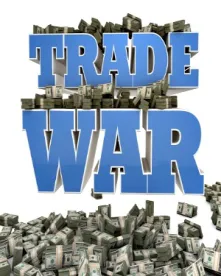Many U.S. companies continue to struggle under the burden of President Trump’s tariffs on imports from China. The repercussions of the trade war are likely to worsen in coming weeks. On March 2, 2019, at 12:01 a.m. Eastern Standard Time, the tariff rate on many Chinese products is scheduled to increase from 10 to 25 percent. At press time for this article (February 21, 2019), negotiations between the United States and China have thus far failed to reach an agreement that would prevent the tariff increase. If no deal is reached, the tariff on all items on so-called List 3 of the Section 301 tariffs will go to 25 percent on March 2. If tariffs are increased to 25 percent, the United States Trade Representative (USTR) may open an exclusion request process for List 3.
Trade War and Tariffs, Full Steam Ahead
As we first predicted in 2017, the Trump administration has opened several battlefronts in what is now a moderately severe trade war with China.
In the spring of 2018, the Trump Administration began imposing tariffs after the USTR’s investigation into unfair Chinese trade practices. That investigation was conducted under Section 301 of the Trade Act of 1974. Section 301 focuses on whether unreasonable or discriminatory trade practices of another country pose an unreasonable burden on U.S. commerce. If so, the statute authorizes the president to impose (among other measures) tariffs on the goods of that country. A tariff is simply an extra tax on the importer, levied as a percentage of the value of the goods.
The investigation of China determined that its practices of intellectual property theft and forced technology transfer warrant Section 301 remedies. As a result, the Trump administration imposed tariffs on three successive lists of goods imported from China, now colloquially referred to as the List 1, List 2, and List 3 tariffs. Currently, there is no set expiration date for the tariffs.
The Wavering Path to the Anticipated March 2 Tariff Increase
The path to the anticipated March 2 tariff increase has been anything but smooth. The List 3 tariffs are currently set at a 10 percent ad valorem duty. Those tariffs have been in effect on $200 billion worth of Chinese imports since September 24, 2018. Those tariffs were set to increase to 25 percent on January 1, 2019.
-
Tariff increase delayed. On December 19, 2018, the eve of the impending deadline, USTR extended the effective date of the increase to March 2, 2018. That extension was intended to allow further negotiations between the United States and China to obtain the elimination of the harmful acts, policies, and practices identified in the investigation. The scope of those negotiations has reportedly expanded to include nontariff barriers, cyber intrusions, cybertheft, and agriculture.
-
Tariff increase back on. As of the end of January 2019, President Trump was showing no signs of backing down on the increase to 25 percent on List 3. Treasury Secretary Steve Mnuchin told reporters that China had offered over 1.2 trillion dollars in additional commitments on trade, but that the offer was rejected. China also offered to buy enough U.S. products to bring the United States-China trade deficit to zero. Negotiations continued, but no deal appeared to be in sight.
-
Trump teases a tariff increase delay. On February 12, 2019, President Trump indicated that he would consider extending the March 2 deadline, but emphasized he was not inclined to do so.
-
Tariff increase expected. A delegation led by Treasury Secretary Mnuchin and USTR Robert Lighthizer went to China on February 14, but those negotiations again yielded no agreement to stop the tariff increase. Negotiations are slated to continue the week of February 25 in Washington, DC. Nevertheless, taking into account the length of the current negotiations, the extent of the current tariffs, and the Chinese practices at issue, we do not expect a resolution by March 2.
Exclusion Request Process May be Available
If the List 3 tariffs are increased to 25 percent, the USTR is likely to open a product exclusion request for List 3, as with prior lists. In a statement issued on February 15, 2018, Congress directed USTR to establish an exclusion request process for List 3 no later than March 18, 2019. That process would follow the same process as previous procedures for Lists 1 and 2. The Congressional statement is not formally part of the Appropriations Act it accompanied, so the statement does not have the binding effect of law. Nevertheless, it provides insight into the intent of Congress, and we think the Trump Administration is unlikely to deny importers at least some chance to request exclusions.
How To Prepare for the Tariff Increase
In our view, the most likely next step is that the List 3 tariffs will increase from 10 to 25 percent starting March 2, 2019. If your imports are on List 3, the change from 10 percent to 25 percent tariff could be devastating to your margins.
U.S. importers continue to brace for the increase. Some companies have reportedly accelerated their purchasing schedules to bring in as much product as possible at 10 percent duties before they increase to 25 percent.
The following may also be useful:
-
Conduct a Harmonized Tariff System classification review. Companies can prepare for the tariff increase by conducting a classification review of products believed to be subject to the tariffs. The tariffs are imposed by classification code on the Harmonized Tariff Schedule (HTS). With its nuances in interpretative rules, changing categories, and extensive case law, HTS classifications are difficult and often prone to error. Sometimes a product may be misclassified under an HTS code included on the Section 301 tariffs lists, and the correct HTS code is excluded from the lists. Companies may conduct an informal classification or request formal classification from Customs and Border Protection (CBP) to determine the correct HTS code. Of course, if you change your classification, you may expect intense scrutiny from CBP. So there is a high premium on getting HTS classification changes right.
-
Watch out for an exclusion request process. We expect that shortly after the imposition of the 25 percent tariff increase, USTR will initiate a process by which companies can request exclusions for products on List 3. That exclusion request process would likely be similar to the processes for Lists 1 and 2. Those requests required a physical description of the product, the HTS code, and the annual quantity and value of the product purchased from China for the last three years, along with policy advocacy in favor of exclusion.
-
Shift supply chains where appropriate. Depending on the product, some companies have been able to shift supply chains in order to source goods from countries other than China. In addition to the business considerations, further legal analysis is needed when shifting a supply chain to ensure compliance with a range of Customs laws. For example, a product made in China but exported to the United States from a middleman country is still subject to the Section 301 tariffs, and engaging in a scheme to evade Section 301 duties in such a manner is unlawful. Additionally, many products are subject to other so-called trade remedies, such as anti-dumping duties and countervailing duties. Those duties can dwarf the Section 301 duties, so be sure your supply chain shift doesn’t land you in the fire from the relative safety of the frying pan.
-
Determine if eligible for duty drawback. If your company imports a Chinese component and conducts manufacturing operations in the United States in which that imported component becomes part of an exported product, you may be eligible for duty drawback. Duty drawback allows a company to recover effectively 99 percent of the duties paid on imported components manufactured into goods that are subsequently exported.
In summary, while the increase from 10 to 25 percent tariffs on List 3 goods from China appears imminent, there are some ways for companies to prepare. Your team of international trade attorneys at Sheppard Mullin is at your disposal to help.




 />i
/>i
